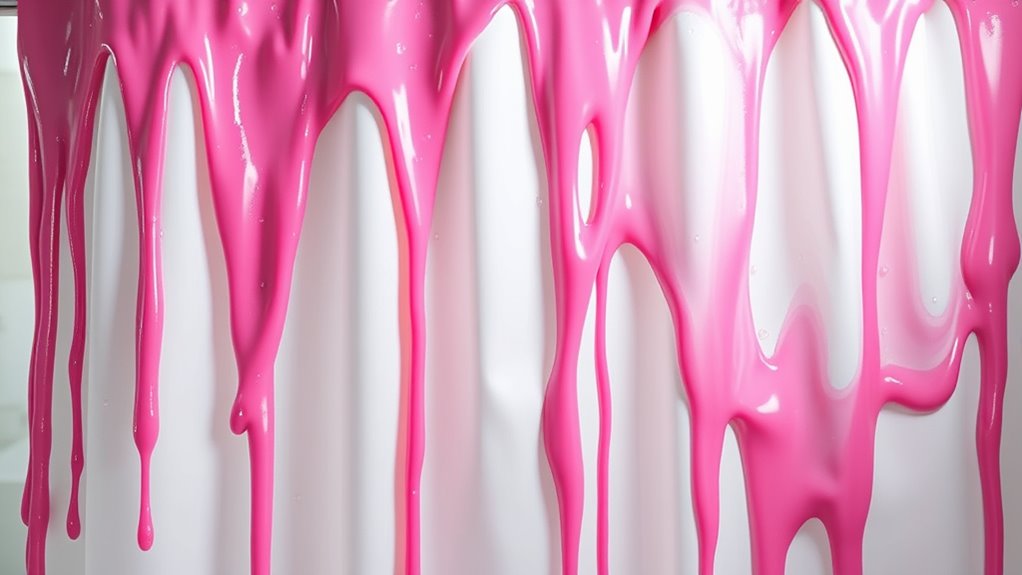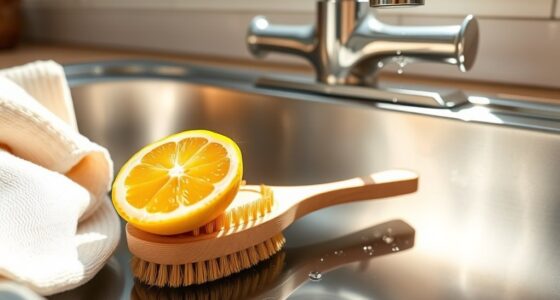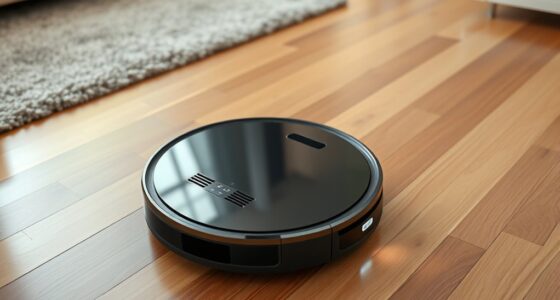Pink slime on your shower curtain is caused by bacteria like Serratia marcescens, which thrive in damp environments. To remove it without harsh bleach fumes, use natural cleaners like white vinegar or baking soda. Spray or scrub your curtain with these, let them sit for a while, then rinse well. Hydrogen peroxide is also effective for disinfecting without fumes. Keep your bathroom dry and ventilated to prevent future buildup. For detailed steps, continue exploring effective, eco-friendly solutions.
Key Takeaways
- Use natural disinfectants like white vinegar or hydrogen peroxide to kill Serratia bacteria without fumes.
- Regularly scrub the shower curtain with baking soda and water to remove pink slime effectively.
- Improve bathroom ventilation by running exhaust fans or opening windows to reduce humidity and bacterial growth.
- Wipe the curtain dry after each shower to prevent moisture buildup that fosters Serratia.
- Consider replacing fabric curtains with mold-resistant, plastic, or vinyl alternatives to inhibit bacterial colonization.
Understanding the Nature of Pink Slime on Shower Curtains
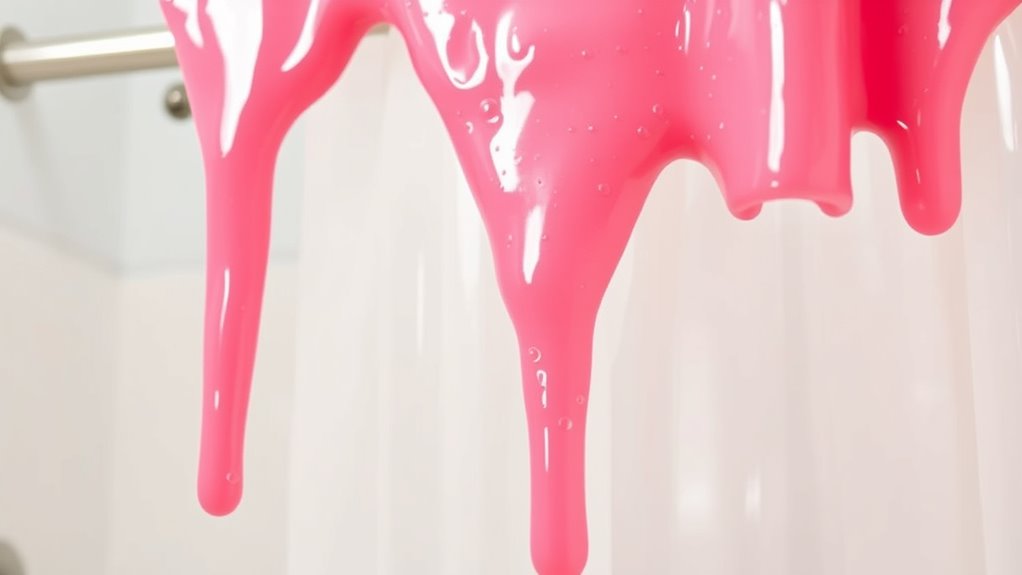
Pink slime on shower curtains is caused by a type of bacteria called *Serratia marcescens*. This bacteria produces a distinct pink or reddish color change on the fabric, making it look unclean even after cleaning. Over time, the bacteria’s presence can lead to fabric deterioration, weakening the material and causing it to become more susceptible to tears or mold. The slimy texture you notice is a sign of bacterial buildup, which thrives in damp, humid environments like your bathroom. Understanding that this pink slime isn’t just dirt but bacteria helps you realize the importance of proper cleaning. It’s not enough to wipe it away; you need to address the bacterial growth to prevent further damage and maintain a hygienic shower curtain. Recognizing the specific bacteria involved can guide you toward more effective cleaning and prevention strategies.
Why Serratia Marcescens Thrives in Bathrooms

Bathrooms are perfect for Serratia marcescens because the humid environment provides ideal conditions for growth. The moisture and warmth help the bacteria thrive on surfaces like shower curtains. Plus, leftover soap scum and skin cells give it plenty of nutrients to feed on. To combat this, creating a digital-friendly environment at home by using smart cleaning tools and educational resources can help maintain hygiene and prevent bacterial buildup.
Humid Environment Advantage
Have you ever wondered why Serratia marcescens seems to flourish in damp environments? The answer lies in the humidity levels and how your bathroom handles moisture. Poor air circulation and inadequate bathroom ventilation trap moisture, creating the perfect setting for bacteria to grow. When your bathroom stays humid, the pink slime on your shower curtain and tiles thrives because the environment stays consistently damp. Without proper airflow, water evaporates slowly, maintaining high humidity. Improving ventilation helps reduce moisture, making it less hospitable for Serratia marcescens. Using exhaust fans or opening windows allows air to circulate better, drying surfaces faster and preventing bacterial buildup. Keeping your bathroom dry and well-ventilated is essential to controlling pink slime and maintaining a cleaner space. Additionally, controlling humidity levels with a dehumidifier can significantly inhibit bacterial growth.
Nutrients in Bathroom
Moist environments in your bathroom don’t just provide the perfect humidity for bacteria to thrive; they also supply the nutrients that Serratia marcescens needs to grow. These nutrients come from everyday items and conditions, including:
- Soap scum and organic residue buildup on surfaces
- Shower curtain materials that trap moisture and dirt
- Leftover shampoo or soap residues in drains
- Poor bathroom ventilation, which keeps moisture and nutrients lingering
- Proper cleaning techniques can help remove these nutrients and inhibit bacterial growth.
Serratia marcescens thrives when these nutrients combine with dampness. To prevent this, ensure your bathroom has good ventilation, dry surfaces regularly, and choose shower curtains that don’t trap grime. Keeping your bathroom clean and well-ventilated starves the bacteria of the nutrients they love.
Safe and Natural Cleaning Agents for Your Shower Curtain
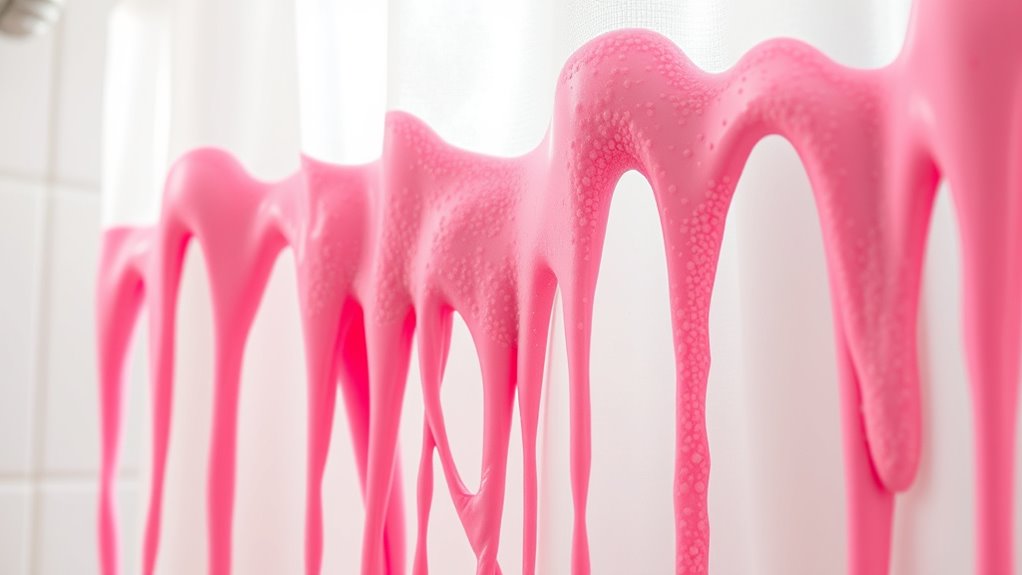
To keep your shower curtain free from pink slime without exposing yourself to harsh chemicals, consider using natural cleaning agents. Eco-friendly cleaners like white vinegar or baking soda effectively combat mold and bacteria while being gentle on your skin and the environment. Natural remedies such as tea tree oil have antifungal properties that can help prevent pink slime buildup. These options are safe, non-toxic, and readily available, making them ideal alternatives to harsh chemicals. Regularly spray or wipe your curtain with a vinegar solution or a mixture of baking soda and water to keep it clean. Not only do these natural remedies eliminate Serratia and other bacteria, but they also help maintain a fresh shower environment without the fumes or residues associated with traditional cleaners. Color accuracy and contrast ratio are important factors in the visual clarity of your shower curtain’s appearance, especially if it features patterns or designs.
How to Disinfect Without Using Harsh Chemicals
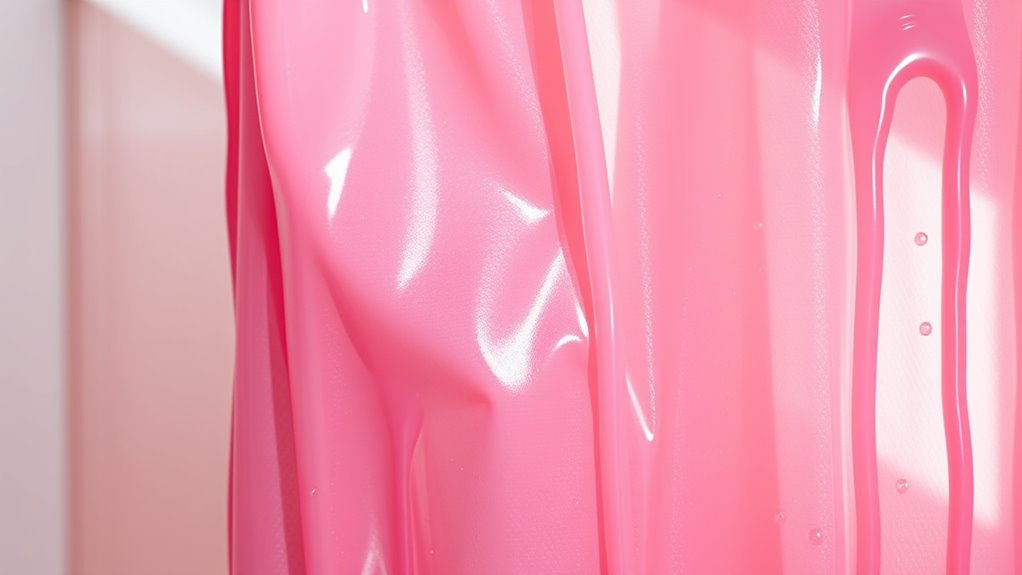
Instead of relying on harsh chemical disinfectants, you can effectively keep your shower curtain germ-free using natural methods. Eco friendly disinfectants are a safe choice that won’t introduce fumes or residue into your home. Incorporating these into your household cleaning routines helps protect your family and the environment. Here are four simple ways to disinfect naturally:
- Use white vinegar—its acidity kills bacteria and mold.
- Apply baking soda for gentle scrubbing and deodorizing.
- Mix hydrogen peroxide with water for an effective, bleach-free disinfectant.
- Regularly air out your shower curtain to prevent mold buildup. Ethical Hacking techniques can also be used to identify vulnerabilities in your cleaning routines and improve safety measures.
These methods are not only eco-friendly but also practical, helping you maintain a clean, healthy bathroom without harsh chemicals.
Step-By-Step Guide to Removing Pink Slime With Vinegar and Baking Soda
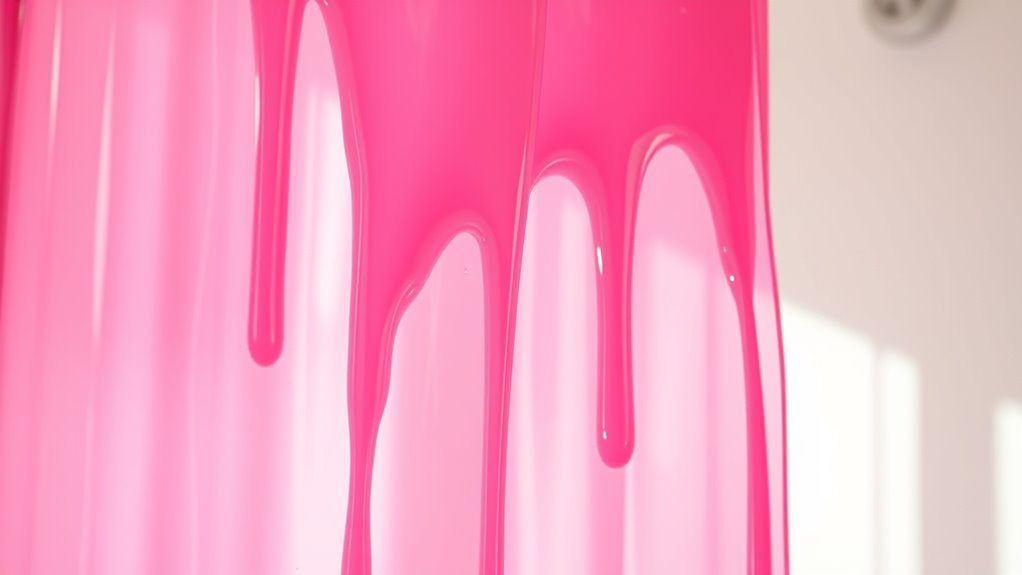
Removing pink slime from your shower curtain is straightforward when you use vinegar and baking soda. Start by mixing equal parts vinegar and water in a spray bottle. Spray the affected areas thoroughly, then sprinkle baking soda over the slime. Let it sit for 15 minutes to break down mold and prevent future buildup. Scrub gently with a soft brush or cloth, focusing on crevices. Rinse with warm water and dry completely to avoid mold growth. Establish a regular cleaning schedule—weekly or biweekly—to keep mold prevention on track and maintain a fresh shower. Regular maintenance, including installing a whole-house water filtration system, can help reduce mineral and microbial buildup that contributes to pink slime.
Using Hydrogen Peroxide for Effective Mold and Bacteria Removal
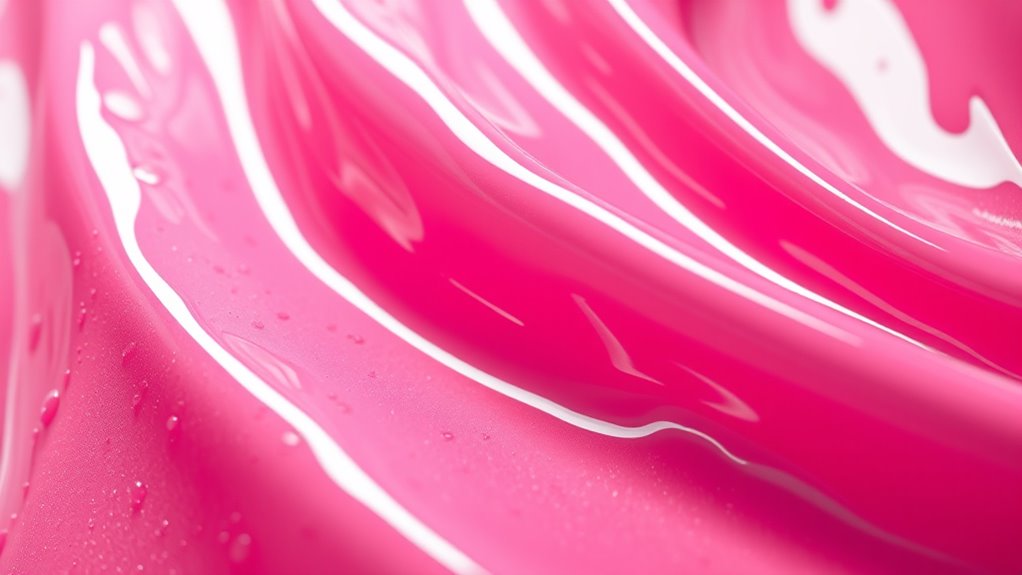
Hydrogen peroxide is a powerful, natural disinfectant that effectively targets mold and bacteria lurking on your shower curtain. It’s a great DIY cleaning solution that doesn’t rely on harsh chemicals, making it a safe household remedy. Here’s how to use it:
- Spray a 3% hydrogen peroxide solution directly onto affected areas.
- Let it sit for 10-15 minutes to break down mold and bacteria.
- Scrub gently with a brush or sponge to loosen grime.
- Rinse thoroughly with water and dry completely.
This method is simple, effective, and eco-friendly, helping you remove stubborn mold without bleach fumes. Incorporate hydrogen peroxide into your household remedies for a safer, more natural approach to keeping your shower curtain clean and fresh.
Preventative Measures to Keep Your Shower Curtain Fresh
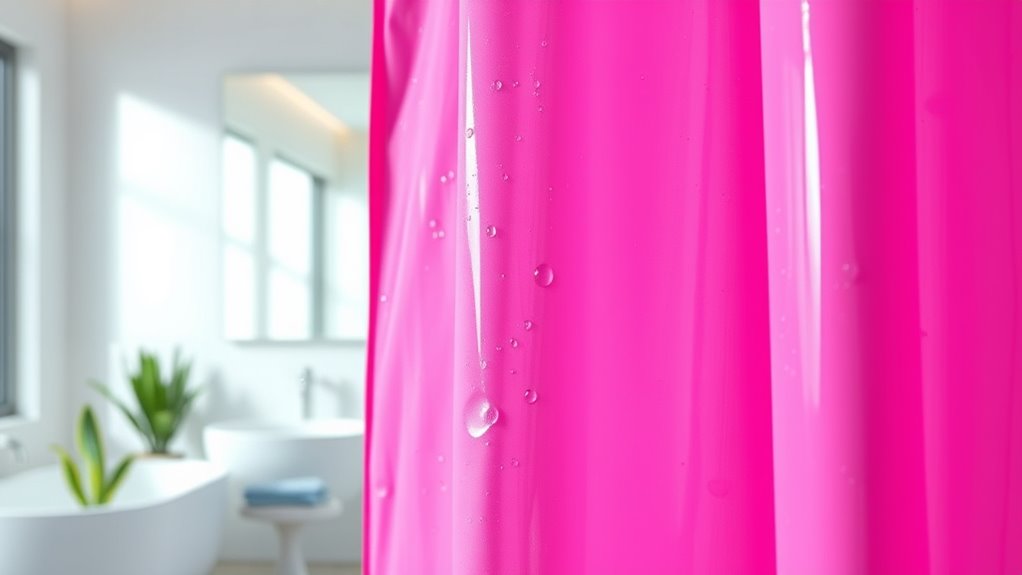
To keep your shower curtain fresh and mold-free, adopting simple preventative habits can make a big difference. Start by ensuring proper shower curtain storage—spread the curtain out fully after each use so it dries quickly and evenly. Avoid folding or crumpling it, which traps moisture and encourages mold growth. Improving bathroom ventilation is also essential; run the exhaust fan during and after showers to reduce humidity. Keep windows open if possible, and wipe down surfaces regularly to prevent moisture buildup. These habits help limit the damp environment that mold thrives in. Additionally, choosing mold-resistant shower curtains can provide an extra layer of protection against Serratia and other mold-forming bacteria. Consistent airflow and proper storage keep your shower curtain dry, fresh, and mold-resistant, reducing the need for frequent cleaning or chemical treatments. Small changes can considerably extend the life and cleanliness of your shower curtain.
Regular Maintenance Tips for a Mold-Free Bathroom
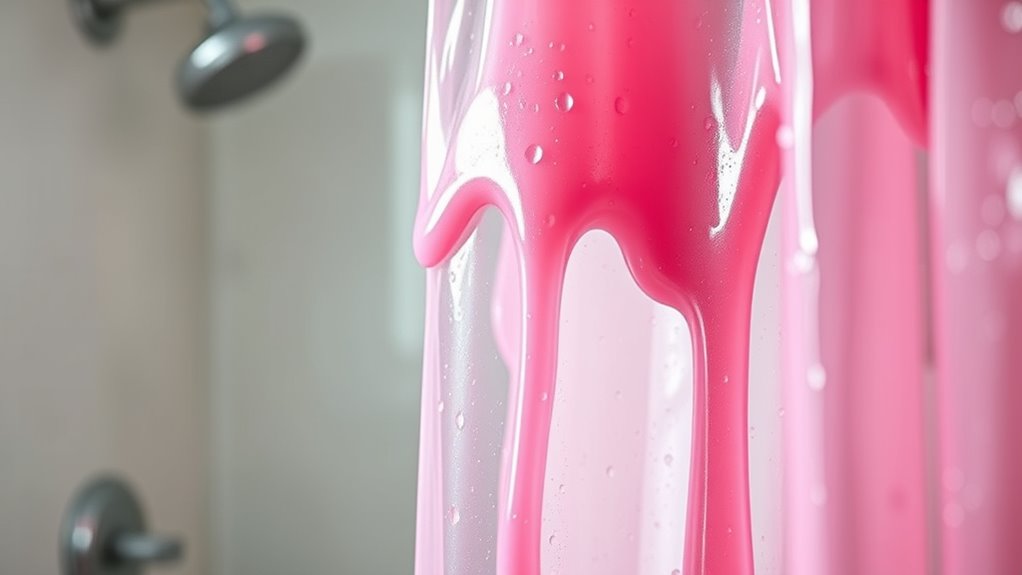
Regular maintenance is key to preventing mold buildup in your bathroom. Good air quality and proper ventilation are essential. Here are four tips to keep your bathroom mold-free:
Regular bathroom maintenance and proper ventilation prevent mold buildup effectively.
- Use exhaust fans or open windows during and after showers to improve ventilation tips.
- Wipe down surfaces like the shower curtain and tiles after use to remove excess moisture.
- Clean regularly with natural solutions like vinegar or hydrogen peroxide to inhibit mold growth.
- Keep bathroom air dry by running fans longer and fixing leaks promptly.
Frequently Asked Questions
Can Pink Slime on Showers Indicate a Health Risk?
Pink slime on your shower curtain can indicate bacterial growth, including potentially harmful bacteria like Serratia. While it might not always guarantee immediate health risks, it can cause infections or respiratory issues, especially if you have a weakened immune system. To minimize health risks, clean the slime regularly using natural solutions like vinegar or baking soda, and make certain proper ventilation to prevent bacterial buildup.
Are There DIY Methods to Prevent Serratia Growth Long-Term?
Sure, your shower can be a microbial paradise, but with some DIY solutions, you can keep Serratia at bay long-term. Regularly scrub with vinegar or hydrogen peroxide, and leave the curtain to dry fully after each use. Preventative measures like improving ventilation and using mold-resistant sprays help too. These simple steps turn your bathroom into a fortress, making it less inviting for the slime and bacteria to thrive.
How Often Should I Replace My Shower Curtain to Avoid Slime?
You should replace your shower curtain every 6 to 12 months to prevent slime buildup and maintain hygiene. Regularly cleaning your curtain, especially with vinegar or baking soda, helps extend its lifespan and reduces the risk of Serratia growth. Keep your bathroom well-ventilated to dry the curtain quickly after showers. By doing these, you’ll effectively prevent slime buildup and enjoy a fresher, cleaner shower environment.
Is Pink Slime Visible to the Naked Eye or Microscopic?
You might notice pink slime with your naked eye, especially if it’s thick or spreads across your shower curtain. Often, it’s visible through visual detection, but sometimes it’s only microscopic, hiding in tiny crevices or on fibers. Coincidentally, regular cleaning can prevent this buildup. Keep an eye out for discoloration or slimy spots, and don’t forget, staying vigilant helps catch pink slime early, whether visible or microscopic.
Can Using Natural Cleaning Agents Harm the Shower Curtain Material?
Using natural cleaning agents generally won’t harm your shower curtain material if you choose gentle, non-abrasive options. These agents typically avoid harsh chemical reactions that could weaken fabric durability. However, some natural substances, like vinegar or lemon juice, may cause discoloration or damage certain materials over time. Always test a small area first, and follow manufacturer instructions to protect your shower curtain from potential damage.
Conclusion
Keep your curtain clean and craving clarity by consistently combating creepy, clingy creases. With simple solutions like vinegar, baking soda, and hydrogen peroxide, you can easily eliminate embarrassing pink slime without nasty fumes. Stay vigilant, ventilate vigorously, and wash often to ward off worrisome, wet mold. By following these friendly, fuss-free tips, you’ll foster a fresh, fungus-free bathroom that feels fabulous and fuss-free every time. Your sparkling shower awaits—stay savvy, stay spotless!
